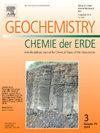Anticlockwise metamorphic evolution of the Tin Hallen area (Ahnet Terrane, NW Hoggar, Algeria): Evidence for granulitic and blueschist-facies metamorphism in Fe-Ti metagabbros
IF 2.9
3区 地球科学
Q2 GEOCHEMISTRY & GEOPHYSICS
引用次数: 0
Abstract
The Tin Hallen area (Ahnet terrane, NW Hoggar, Algeria) represents one of the most well-preserved examples of blueschist-facies metamorphism in West Gondwana, associated with Fe![]() Ti garnet-bearing metagabbros. The textural analysis reveals four distinct stages. The first stage (M1) is magmatic, characterized by an orthopyroxene, plagioclase ± clinopyroxene, and ilmenite assemblage, primarily observed in areas distant from shear zones. The second stage (M2) involves the development of granulite-facies coronae and symplectites composed of garnet, clinopyroxene2, quartz, rutile, and brown amphibole. The third stage (M3) is defined by the appearance of green amphibole, sphene and epidote. Finally, the fourth stage (M4) is marked by the formation of glaucophane-bearing schists, indicating an advanced retrograde evolution within shear zones. Through the integration of thermodynamic modeling (P-T-MH2O pseudosections), petrology, mineral chemistry, and reaction textures, a counterclockwise P-T path has been established for the area. The Tin Hallen metagabbros display a prominent granulitic imprint surrounding magmatic relicts in H2O-undersaturated conditions. This evolution reflects a pressure increase at nearly constant temperature, progressing from c. 6 kbar and c. 900 °C (M1) to 9–10.5 kbar and 850–900 °C (M2), likely linked to the thickening of the magmatic arc root, as suggested by other international studies. The granulitization is followed by further pressure increases and temperature decreases, leading to the mylonitic garnet amphibolite stage (M3) at ~14 kbar and 740 °C, along with a significant rise in MH2O. Moreover, the presence of an original blueschist-facies stage (M4) with high-pressure, low-temperature (HP-LT) conditions (c. 8 kbar and 470 °C) is characteristic of cold subduction gradients (10–15 °C/km).
Ti garnet-bearing metagabbros. The textural analysis reveals four distinct stages. The first stage (M1) is magmatic, characterized by an orthopyroxene, plagioclase ± clinopyroxene, and ilmenite assemblage, primarily observed in areas distant from shear zones. The second stage (M2) involves the development of granulite-facies coronae and symplectites composed of garnet, clinopyroxene2, quartz, rutile, and brown amphibole. The third stage (M3) is defined by the appearance of green amphibole, sphene and epidote. Finally, the fourth stage (M4) is marked by the formation of glaucophane-bearing schists, indicating an advanced retrograde evolution within shear zones. Through the integration of thermodynamic modeling (P-T-MH2O pseudosections), petrology, mineral chemistry, and reaction textures, a counterclockwise P-T path has been established for the area. The Tin Hallen metagabbros display a prominent granulitic imprint surrounding magmatic relicts in H2O-undersaturated conditions. This evolution reflects a pressure increase at nearly constant temperature, progressing from c. 6 kbar and c. 900 °C (M1) to 9–10.5 kbar and 850–900 °C (M2), likely linked to the thickening of the magmatic arc root, as suggested by other international studies. The granulitization is followed by further pressure increases and temperature decreases, leading to the mylonitic garnet amphibolite stage (M3) at ~14 kbar and 740 °C, along with a significant rise in MH2O. Moreover, the presence of an original blueschist-facies stage (M4) with high-pressure, low-temperature (HP-LT) conditions (c. 8 kbar and 470 °C) is characteristic of cold subduction gradients (10–15 °C/km).
阿尔及利亚NW Hoggar Ahnet地块Tin Hallen地区的逆时针变质演化:铁-钛变质岩中粒状和蓝片岩相变质的证据
Tin Hallen地区(阿尔及利亚NW Hoggar的Ahnet地体)是西Gondwana地区保存最完好的蓝片岩相变质岩之一,与含铁钛石榴石的变质岩有关。结构分析揭示了四个不同的阶段。第一阶段(M1)为岩浆期,以正辉石、斜长石±斜辉石和钛铁矿组合为特征,主要分布在远离剪切带的地区。第二阶段(M2)发育由石榴石、斜辉石英2、石英、金红石和棕色角闪洞组成的麻粒岩相日冕和共长岩。第三阶段(M3)以绿色角闪洞、榍石和绿帘石的出现为标志。第四阶段(M4)以含蓝绢岩片岩的形成为标志,显示出剪切带内的晚期逆行演化。通过热力学模拟(P-T- mh2o伪剖面)、岩石学、矿物化学和反应结构的整合,建立了该区的逆时针P-T路径。在欠饱和条件下,锡海伦变质长岩在岩浆遗迹周围显示出明显的粒状印记。这种演化反映了在几乎恒定的温度下压力的增加,从摄氏6 kbar和摄氏900°c (M1)发展到9-10.5 kbar和850-900°c (M2),这可能与其他国际研究表明的岩浆弧根部增厚有关。粒粒化之后,压力进一步升高,温度进一步降低,在~14 kbar和740℃下形成糜棱岩石榴石角闪岩阶段(M3),同时MH2O显著升高。此外,具有高压、低温(HP-LT)条件(c. 8 kbar和470℃)的原始蓝片岩相阶段(M4)的存在具有冷俯冲梯度(10-15℃/km)的特征。
本文章由计算机程序翻译,如有差异,请以英文原文为准。
求助全文
约1分钟内获得全文
求助全文
来源期刊

Chemie Der Erde-Geochemistry
地学-地球化学与地球物理
CiteScore
7.10
自引率
0.00%
发文量
40
审稿时长
3.0 months
期刊介绍:
GEOCHEMISTRY was founded as Chemie der Erde 1914 in Jena, and, hence, is one of the oldest journals for geochemistry-related topics.
GEOCHEMISTRY (formerly Chemie der Erde / Geochemistry) publishes original research papers, short communications, reviews of selected topics, and high-class invited review articles addressed at broad geosciences audience. Publications dealing with interdisciplinary questions are particularly welcome. Young scientists are especially encouraged to submit their work. Contributions will be published exclusively in English. The journal, through very personalized consultation and its worldwide distribution, offers entry into the world of international scientific communication, and promotes interdisciplinary discussion on chemical problems in a broad spectrum of geosciences.
The following topics are covered by the expertise of the members of the editorial board (see below):
-cosmochemistry, meteoritics-
igneous, metamorphic, and sedimentary petrology-
volcanology-
low & high temperature geochemistry-
experimental - theoretical - field related studies-
mineralogy - crystallography-
environmental geosciences-
archaeometry
 求助内容:
求助内容: 应助结果提醒方式:
应助结果提醒方式:


